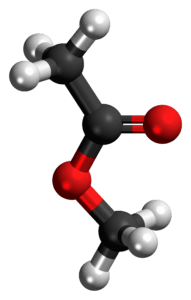 It is possible to determine experimentally the equilibrium constant for the reaction between methanol, CH3.OH, and ethanoic acid, CH3.COOH, to form the ester methyl ethanoate, CH3.CO.OCH3, and water. The esterification is catalysed by hydrogen ions.
It is possible to determine experimentally the equilibrium constant for the reaction between methanol, CH3.OH, and ethanoic acid, CH3.COOH, to form the ester methyl ethanoate, CH3.CO.OCH3, and water. The esterification is catalysed by hydrogen ions.
The reaction is reversible and proceeds slowly towards an equilibrium. It is therefore necessary to set up the experiment and leave it for a week before the calculation is to be completed. The concentration of ethanoic acid in the equilibrium mixture is then determined by titration with a standardised 1 mol l-1 sodium hydroxide solution. If the initial concentrations of the methanol and ethanoic acid are known, the equilibrium constant can then be calculated.
As an interesting exercise and teaching point, the same equilibrium mixture can be formed by the hydrolysis of methylethanoate. Once again the equilibrium concentrations of all species can be found and hence the equilibrium constant calculated for the reaction. The value of K should be equal to that found from the formation of the ester.



